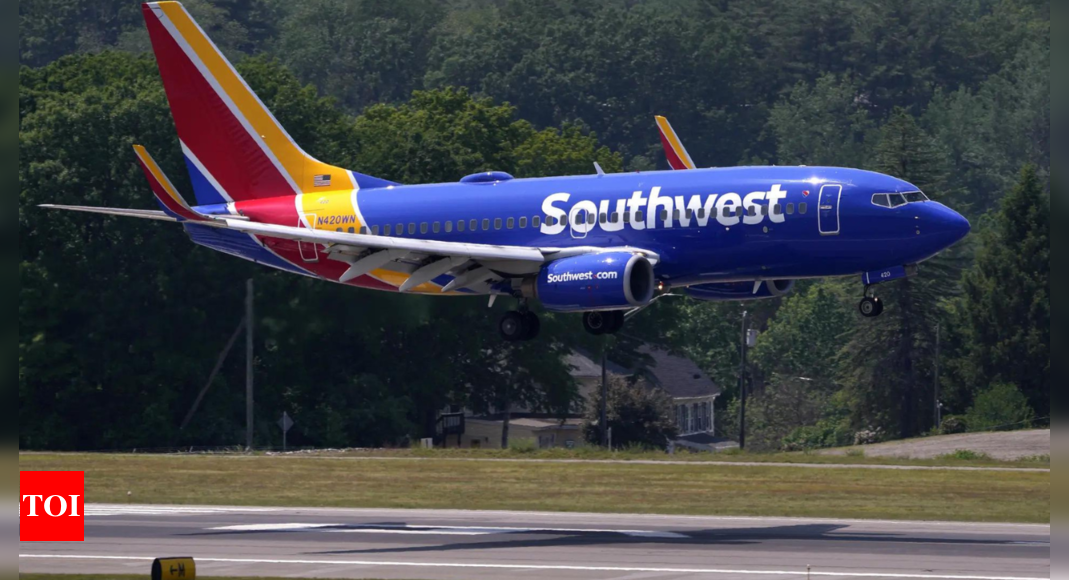
Major US airline operator Southwest Airlines is set to discontinue its open seating policy, which has been a distinctive feature of the airline for over 50 years. The announcement comes amid pressure from an activist investor seeking changes in the company’s leadership and operating strategy, reported the Wall Street Journal.
The shift will involve assigned seats with some having extra legroom, marking a significant shift for Southwest, as the model has contributed to the airline’s long-standing profitability and democratization of air travel.Southwest Chief Executive Bob Jordan believes that this change is necessary to meet the evolving preferences of customers. The exact timing for the implementation of assigned seats and premium rows is yet to be determined, but bookings for these options are expected to commence next year, pending regulatory approval and the retrofitting of planes. “This is the right change at the right time,” said Jordan.
Despite achieving record quarterly operating revenue, Southwest reported a 46% decrease in second-quarter profit compared to the previous year. The airline acknowledged that it sold many summer tickets too early, resulting in the loss of lucrative last-minute bookings. However, the profit still surpassed analysts’ expectations. The company’s shares experienced a decline of 3.8% in premarket trading on Thursday, following a 7.9% drop year-to-date, in contrast to a 14% gain in the S&P 500.
Elliott Investment Management, a prominent hedge fund with a substantial stake in Southwest, has criticized the airline for its slow adaptation to modern flying practices. In a letter to the airline’s board, Elliott expressed that the proposed changes are insufficient and overdue, and that many investors have lost faith in the company’s leadership.
Southwest’s plan aims to alleviate the pressure on passengers to check in precisely 24 hours in advance or pay extra for a favorable spot in the boarding queue. While open seating has been appreciated by the airline’s fans, especially when flights were less crowded, this is becoming less common as planes are now more packed. A survey conducted by the airline revealed that 80% of customers preferred assigned seats. Surprised by the results, chief executive Jordan said, “Our customers really, really, really want it.”
The airline is optimistic that these changes will attract more passengers, including those who may not have previously considered Southwest. As the company targets more corporate travelers, it has observed that frequent flyers have little interest in unpredictable seating arrangements. Many Southwest employees also support the change, with executives noting that the airline received more internal complaints when it stopped serving peanuts on flights than when it began discussing these potential changes.
To test various boarding methods, Southwest conducted trials in Houston, to ensure that the changes does“not compromise the airline’s operational efficiency”, enlisting employees and their families to practice boarding and deplaning over several days. The airline set up cameras to monitor movements and equipped some testers with Google Glass devices to gain a first-person perspective on the process. The findings were confirmed through millions of computer simulations, leading Southwest to conclude that it could implement the change without disrupting operations.
Jordan acknowledged that there might be a small but vocal group of loyal customers who are skeptical about the transformation. However, he remains confident that the airline will be able to win them over.
Apart from the shift in seating policy, Southwest Airlines is also introducing red-eye flights, which means late-night or overnight flights. Beginning in February of the upcoming year, Southwest Airlines will be launching overnight flights on five initial routes. These routes include Las Vegas to Baltimore and Orlando, Los Angeles to Baltimore and Nashville, and Phoenix to Baltimore. These changes are also aimed to increase revenue according to the airlines.
The shift will involve assigned seats with some having extra legroom, marking a significant shift for Southwest, as the model has contributed to the airline’s long-standing profitability and democratization of air travel.Southwest Chief Executive Bob Jordan believes that this change is necessary to meet the evolving preferences of customers. The exact timing for the implementation of assigned seats and premium rows is yet to be determined, but bookings for these options are expected to commence next year, pending regulatory approval and the retrofitting of planes. “This is the right change at the right time,” said Jordan.
Despite achieving record quarterly operating revenue, Southwest reported a 46% decrease in second-quarter profit compared to the previous year. The airline acknowledged that it sold many summer tickets too early, resulting in the loss of lucrative last-minute bookings. However, the profit still surpassed analysts’ expectations. The company’s shares experienced a decline of 3.8% in premarket trading on Thursday, following a 7.9% drop year-to-date, in contrast to a 14% gain in the S&P 500.
Elliott Investment Management, a prominent hedge fund with a substantial stake in Southwest, has criticized the airline for its slow adaptation to modern flying practices. In a letter to the airline’s board, Elliott expressed that the proposed changes are insufficient and overdue, and that many investors have lost faith in the company’s leadership.
Southwest’s plan aims to alleviate the pressure on passengers to check in precisely 24 hours in advance or pay extra for a favorable spot in the boarding queue. While open seating has been appreciated by the airline’s fans, especially when flights were less crowded, this is becoming less common as planes are now more packed. A survey conducted by the airline revealed that 80% of customers preferred assigned seats. Surprised by the results, chief executive Jordan said, “Our customers really, really, really want it.”
The airline is optimistic that these changes will attract more passengers, including those who may not have previously considered Southwest. As the company targets more corporate travelers, it has observed that frequent flyers have little interest in unpredictable seating arrangements. Many Southwest employees also support the change, with executives noting that the airline received more internal complaints when it stopped serving peanuts on flights than when it began discussing these potential changes.
To test various boarding methods, Southwest conducted trials in Houston, to ensure that the changes does“not compromise the airline’s operational efficiency”, enlisting employees and their families to practice boarding and deplaning over several days. The airline set up cameras to monitor movements and equipped some testers with Google Glass devices to gain a first-person perspective on the process. The findings were confirmed through millions of computer simulations, leading Southwest to conclude that it could implement the change without disrupting operations.
Jordan acknowledged that there might be a small but vocal group of loyal customers who are skeptical about the transformation. However, he remains confident that the airline will be able to win them over.
Apart from the shift in seating policy, Southwest Airlines is also introducing red-eye flights, which means late-night or overnight flights. Beginning in February of the upcoming year, Southwest Airlines will be launching overnight flights on five initial routes. These routes include Las Vegas to Baltimore and Orlando, Los Angeles to Baltimore and Nashville, and Phoenix to Baltimore. These changes are also aimed to increase revenue according to the airlines.









